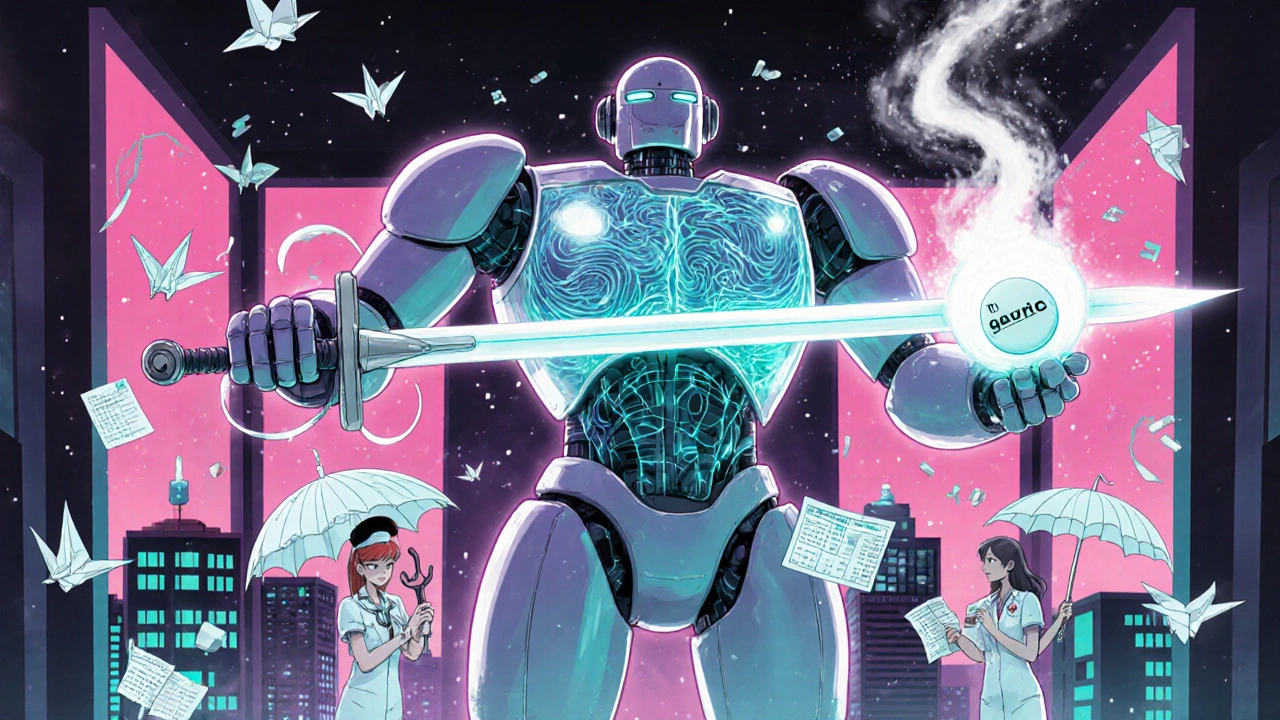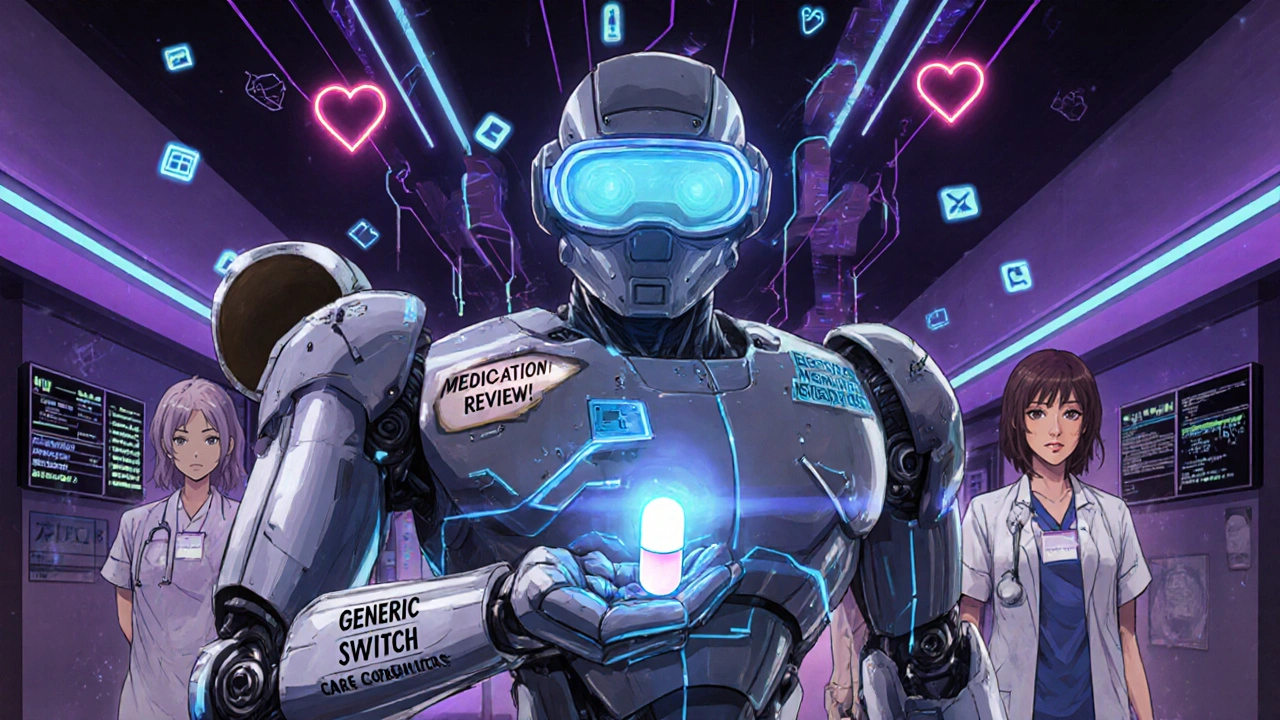When it comes to prescribing medications, especially generics, the old model of one doctor making decisions alone is falling behind. Patients with multiple chronic conditions-like diabetes, high blood pressure, or heart failure-are often juggling five or more drugs. Mistakes happen. Costs pile up. Adherence drops. But there’s a better way: team-based care. It’s not just a buzzword. It’s a proven system where pharmacists, nurses, care coordinators, and physicians work together-on the same page-to make smarter, safer, and more affordable medication choices.
Why Team-Based Care Matters for Generic Prescribing
Generic drugs work just like brand-name versions but cost 80% less on average. Yet, many patients still get branded medications because no one bothered to ask if a generic would work. That’s where team-based care changes the game. In a traditional setup, a physician might write a prescription in 5 minutes, never knowing if the patient can afford it or if there’s a safer, cheaper alternative. In a team-based model, the pharmacist steps in. They run a full medication review, flagging interactions, duplications, and unnecessary brand-name drugs. They then recommend generics that are clinically equivalent-and they do it before the patient leaves the clinic. A 2023 study from PureView Health Center found that practices using team-based medication management saved patients $1,200 to $1,800 per year just by switching to appropriate generics and avoiding hospital readmissions. That’s not theoretical. That’s real money in patients’ pockets. And it’s not just about cost. It’s about safety. Pharmacists caught three or more dangerous drug interactions in one out of every five patients with complex regimens, according to patient reviews on Healthgrades.Who’s on the Team and What Do They Do?
Team-based care isn’t chaos with extra people. It’s structure. Each role has clear responsibilities:- Physicians handle complex diagnoses and make final decisions on high-risk medications. They don’t disappear-they focus on what only they can do.
- Pharmacists are the medication experts. They review every drug, check for interactions, suggest generics, and educate patients on how to take them. In practices with strong collaboration, pharmacists reduce medication errors by 67%, according to the American Pharmacists Association.
- Nurses and Medical Assistants monitor chronic conditions, track blood pressure or blood sugar, and handle routine follow-ups. They free up the doctor’s time so they’re not stuck managing refills.
- Care Coordinators make sure everyone talks. They update electronic records, schedule huddles, and ensure prescriptions flow smoothly between specialists and primary care.
How It Works in Real Life
Imagine a 68-year-old with diabetes, hypertension, and high cholesterol. She’s on eight medications. Her doctor is overwhelmed. She’s missing doses. Her co-pay is $300 a month. In a team-based model, here’s what happens:- During her visit, the medical assistant checks her vitals and updates her record.
- The pharmacist does a full medication review using the clinic’s EHR. They spot that her metformin is brand-name, her atorvastatin is unnecessary at her current dose, and her lisinopril has a cheaper generic alternative.
- The pharmacist sends a note to the doctor with three specific recommendations: switch metformin to generic, reduce atorvastatin from 40mg to 20mg, and switch lisinopril to the generic.
- The doctor reviews and approves-all in under 90 seconds.
- The care coordinator calls the patient, explains the changes, and helps her get the new prescriptions filled at a discount pharmacy.

Where It’s Working Best
Team-based care isn’t just for big hospitals. It’s thriving in community clinics, VA facilities, and even rural telehealth setups. Medicare Part D’s Medication Therapy Management (MTM) program serves over 12 million people in 2023, with 87% of plans using pharmacists to manage medications. The CDC’s 2023 Cardiovascular Health Resource Guide now explicitly recommends team-based approaches for managing blood pressure, with pharmacists leading generic substitution efforts. Rural areas are seeing the biggest gains. Before telepharmacy, patients in remote towns had to drive 40 miles to see a pharmacist. Now, they get virtual medication reviews through secure video calls. Between 2020 and 2023, telepharmacy services grew by 214%. That means someone in Appalachia or the Outback can get the same level of medication oversight as someone in Sydney or Chicago.The Challenges-And How to Overcome Them
It’s not perfect. Setting this up costs between $85,000 and $120,000 per practice, according to VA research. Some doctors resist sharing control. Electronic systems don’t always talk to each other. And paperwork? It’s still a mess. But the fixes are practical:- Start small. Pilot with one chronic condition-like hypertension-before expanding.
- Use collaborative practice agreements (CPAs). These legal documents spell out exactly what pharmacists can do, reducing liability fears. The CDC has a free template.
- Hold daily 15-minute huddles. Five minutes to update each other. Ten minutes to solve problems. That’s it.
- Train your team. Pharmacists need PharmD degrees and post-graduate training. Nurses need protocols. Everyone needs to know how to use the EHR.
What’s Next? AI and Policy Changes
The future is already here. In pilot programs at Mayo Clinic, AI tools now suggest generic alternatives based on a patient’s history, allergies, and cost. These suggestions are reviewed by pharmacists before being sent to the doctor. The result? A 22% increase in appropriate generic use and a 9.3% drop in adverse events. Policy is catching up too. In 2023, Medicare expanded MTM eligibility to patients taking four or more medications-down from five. That adds 4.2 million more people to the program. And 92% of healthcare executives plan to expand team-based care in the next two years. The big question? Reimbursement. Only 41% of team-based medication services are currently paid enough to cover costs. That’s changing. States are passing laws to allow pharmacists to bill for medication reviews. Medicare Advantage plans are required to offer comprehensive medication management. The money trail is starting to follow the evidence.
What Patients Are Saying
Real stories tell the real story. One patient on Healthgrades wrote: “The pharmacist caught three interactions my doctor missed. Switched me to generics. Saved me $200 a month. I finally feel like someone’s looking out for me.” Another, on Reddit’s r/medicine, shared: “I used to dread my meds. Now my pharmacist calls me every month to check in. I take them. I feel better. And I’m not broke.” Not everyone’s happy. About 12% of reviews mention confusion when team members don’t communicate. But those are the cases where the system broke down-not because the model is flawed, but because it wasn’t done right.Final Thought: It’s Not About Replacing Doctors. It’s About Supporting Them.
Team-based care doesn’t take power away from physicians. It gives them back their time. It lets them focus on the hard cases-the rare diagnoses, the complex adjustments, the human moments that machines can’t replicate. Meanwhile, the team handles the routine, the repetitive, the costly mistakes. Generic prescribing isn’t just about saving money. It’s about access. Equity. Safety. When a patient chooses between food and medicine, the system has failed. Team-based care fixes that.Frequently Asked Questions
What is team-based care in medication management?
Team-based care in medication management is a collaborative model where physicians, pharmacists, nurses, and care coordinators work together to optimize drug therapy. Each member has defined roles: pharmacists review medications and suggest generics, nurses monitor chronic conditions, and care coordinators ensure communication. The goal is safer, more affordable, and more effective treatment, especially for patients with multiple chronic diseases.
Can pharmacists really prescribe generic medications?
In many states and under collaborative practice agreements (CPAs), pharmacists can initiate, modify, or switch medications-including to generics-under agreed-upon protocols. They don’t replace physicians, but they can make these changes without waiting for a doctor’s note, especially for stable conditions like hypertension or diabetes. This is legally allowed in over 40 U.S. states and is expanding in Australia and Canada.
Is team-based care only for Medicare patients?
No. While Medicare Part D’s MTM program is the largest driver, team-based care is used by private insurers, VA hospitals, community health centers, and even private practices. Any patient with multiple chronic conditions and complex medication regimens can benefit, regardless of insurance type.
How do I know if my clinic uses team-based care?
Look for signs: Is there a pharmacist in the clinic? Do they ask about all your meds, not just the new one? Do nurses check your blood pressure or glucose before you see the doctor? Do you get a call from someone after your visit about your prescriptions? If yes, you’re likely in a team-based model. Ask directly: “Do you have a pharmacist on your care team who reviews medications?”
Why aren’t all clinics using this model?
Cost and complexity. Setting up team-based care requires training, new workflows, and compatible electronic systems. Small practices often lack the resources. Reimbursement is still inconsistent-only 41% of services are paid enough to cover costs. But adoption is growing fast, especially in accountable care organizations and large health systems where savings outweigh upfront investment.

fiona collins
November 25, 2025 AT 19:54Team-based care isn’t just smart-it’s essential.
Pharmacists aren’t just pill counters; they’re safety nets.
I’ve seen it firsthand: a patient on eight meds, confused, broke, scared.
Then a pharmacist stepped in.
Generic switch. $200 saved. Adherence jumped.
No drama. No yelling. Just quiet, competent care.
This isn’t theory. It’s Tuesday.